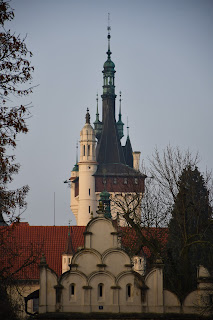From Victoria Falls to the Skeleton Coast – Day 9: A stopover at a Herero village
Originally, our plan for our last full day in Namibia had been to visit Twyfelfontein and at least one of the petrified forests farther north. We made such good time the day before, however, that we checked off everything on the list and found ourselves scrambling for ideas. We needed to reach Windhoek by evening to return the rental car and check into our hotel, so we could not travel too far, like Etosha or the Hoba Meteorite in the north or Brandberg in the southwest. There was also the added pressure of money. Our cash reserves depleted much faster than we had expected, and once we had paid for our hotel (we could not use our US Dollars or credit cards), we were left with little more than four hundred Namibian Dollars – barely enough to fill half a tank.
The hotel
owner mentioned the previous evening that he had visited a bank in Khorixas,
one of the towns along the shortest route to Windhoek. It was also possible, he
confirmed, to pay at most of the gas stations using a card. Armed with this
information, we headed to Khorixas, which was about an hour’s distance away,
and succeeded in solving our most pressing problems. The gas station did indeed
accept credit payments and the bank – despite not being on Google Maps – had a
whole two ATMs, one of which mercifully decided to work that day.
Searching online
for attractions en route to Windhoek, we found a place called Ombu Village. The
road there was a little confusing and involved letting ourselves in through a
gate, but after some time driving along dirt paths up and down the hills, we
made it to a semicircle of mud huts, behind which stood a large building that
served as a reception, museum, and gift shop. After a quick welcome and
explanation about the village, the guide on duty let us wander through the
indoor museum, which consisted of a few artefacts and panels. The village, we
learned, belonged to the Herero people, whom we had seen beckoning us to their
gift shops in their colourful dresses while we were on our way to
Twyfelfontein. We learned that women had adopted these dresses during the
colonial period, and that their wide hats honoured the horns of cows.
The Herero
contain several subgroups, perhaps the most famous of which are the Himba, who
have retained their traditional way of life. They wear clothes made of cowhides
and the women fashion their hair into large, seemingly solid pleats. The village
we visited, however, belonged to the Herero who had adopted and adapted Western
clothes and customs. They retain some form of ancestor worship, with the
village’s sacred fire being used to communicate with deceased relatives and ask
them to intercede on their behalf with the foremost god. Nonetheless, the
Herero are mostly Christian. Their lifestyle revolves around cattle, who
constitute a woman’s bridal price and whose meat and milk, alongside corn, form
the bulk of the tribe’s traditional sustenance.
The guide
led us through the village, which comprised several traditional mud houses with
exhibits, as well as several slightly modern houses which, I presume, were the
actual homes of the family living there. Our visits to the mud houses involved
demonstrations by two local women of how the Herero traditionally make spices,
how they perfume their clothes and bodies, and how they churn butter. We also
entered the sheep and cow pens, in the latter of which the younger of the two
women showed us how to milk a cow. As the white jets kept pummelling the side
of the bucket, I realised that it never really occurred to me how much milk an
udder can store.
After
visiting the Herero village and museum, we wanted to drive through the nearby
game reserve, but we were told at the entrance that without a reservation, we
would not be able to enter outside the usual entry times of eleven and one
o’clock. Instead, we decided to look for lunch. This turned out to be a more
difficult task than we had envisioned, as even on this well-paved road to the
capital city, the closest restaurant was in a town over an hour away. Our last
stop for the day was going to be the Heroes’ Acre just south of Windhoek. The
attraction, built by North Korea’s Mansudae Overseas Projects, consists of a
massive white pillar and the statue of a fully armed fighter. By the time we
had arrived by the gate, however, the gargantuan complex had closed, and we
ended up trying to find a good spot to view it from the nearby roads.














Comments
Post a Comment